Comparative Study on the Cooling Effects of Green Space Patterns in Waterfront Build-Up Blocks: An Experience from Shanghai
Abstract
1. Introduction
2. Study Area and Methodology
2.1. Methodological Framework
2.2. Study Area
2.3. Spatial Description Variables of the Waterfront Green Space Network
2.3.1. Multidimensional Spatial Variables Framework
2.3.2. Control Variables
2.3.3. Quantifying the Spatial Configurations Variables
The Network Structure Variables
The Morphological Factors at the Microlevel
2.4. Simulation Model and Scheme Design
2.4.1. Urban Design Methods for the Green Space Network
2.4.2. ENVI-Met Dynamic Simulation Method
2.5. Statistical Methods
2.5.1. The Holistic Thermal Environment Status Analysis
2.5.2. The Contribution Proportion of Multidimensional Spatial Variables to the Cooling Effect
2.5.3. Marginal Effect and Correlation Analysis of Individual Spatial Factors to Cool Effect
3. Results
3.1. Component Contribution Analysis on Cool Islands from the Waterfront Green Space Network
3.1.1. Characteristic Analysis of the Cool Island for the Holistic Network
3.1.2. Relative Importance of Spatial Variables of Green Space to the Cooling Effect
3.2. Structural Spatial Variables Affecting Cooling Effects from the Green Space Network
3.2.1. Distance from Water Body (Dwb)
3.2.2. The dPC (Decreased Probability Connectivity) Variable
3.2.3. Green Corridor Orientation
3.2.4. MSPA Types
3.3. Cooling Impact Analysis of the Spatial Morphology Variables
The Variables of the Surface Coverage Morphology and Ambient Factors
3.4. Sky View Factor (SVF)
Green Corridor Width (GWd)
4. Discussion
4.1. Implications for Urban Climatic Adaptive Design
- (1)
- Optimal spatial composition between blue and green space for maximized SCE.
- (2)
- Practical structural patterns of the waterfront green space network for holistic cooling effects.
- (3)
- Complex influence of three-dimensional morphology and the ambient interface of the green space network.
4.2. Differences from Previous Studies
4.3. Limitations of This Study
5. Conclusions
Author Contributions
Funding
Acknowledgments
Conflicts of Interest
Abbreviations
| Synergistic cooling effect; UCI: Urban cool | SCE |
| Urban heat island | UHI |
| Water cool island | WCI |
| Urban green space cool island | UGCI |
| Air temperature (°C) | T |
| Surface temperature (°C) | Tsurface |
| The difference between T and the mean T of the entire study area | ΔT |
| Coefficient of variation | CV |
| Coefficient of variation of air temperature | CV-T |
| Boosted regression trees | BRT |
| Marginal effect | ME |
| threshold value of efficiency | TVoE |
| Block no. 1/no. 2/no. | Block N1/N2/N3 |
| East-west orientation | E–W |
| South-north orientation | S–N |
| Southwest-northeast orientation | WS–EN |
| Southeast-northwest orientation | ES–WN |
| Morphological spatial pattern analysis | MSPA |
| Probability of connectivity | PC |
| The decrease probability connectivity | dPC |
| Distance from water body | DWb |
| Green corridor width | GWd |
| Landscape Shape Index | LSI |
| Green space ratio | GR |
| Green space area | GA |
| Sky view factor | SVF |
| Vegetation structure | VSt |
| Vegetation surface albedo | VSAlbedo |
| Patch/Corridor pattern | P/C pattern |
| Local Climate Zone | LCZ |
References
- Shi, D.C.; Song, J.Y.; Huang, J.X.; Zhuang, C.Q.; Guo, R.; Gao, Y.F. SCEs (SCEs) of urban green-blue spaces on local thermal environment: A case study in Chongqing, China. Sustain. Cities Soc. 2020, 55, 102065. [Google Scholar] [CrossRef]
- Du, H.; Cai, Y.; Zhou, F.; Jiang, H.; Jiang, W.; Xu, Y. Urban blue-green space planning based on thermal environment simulation: A case study of Shanghai, China. Ecol. Indic. 2019, 106, 105501. [Google Scholar] [CrossRef]
- Roebeling, P.; Saraiva, M.; Palla, A.; Gnecco, I.; Teotónio, C.; Fidelis, T.; Martins, F.; Alves, H.; Rocha, J. Assessing the socio-economic impacts of green/blue space, urban residential and road infrastructure projects in the Confluence (Lyon): A hedonic pricing simulation approach. J. Environ. Plan. Manag. 2017, 60, 482–499. [Google Scholar] [CrossRef]
- Nouri, H.; Borujeni, S.C.; Hoekstra, A.Y. The blue water footprint of urban green spaces: An example for Adelaide, Australia. Landsc. Urban. Plan. 2019, 190, 103613. [Google Scholar] [CrossRef]
- Yu, Z.; Yang, G.; Zuo, S.; Jørgensen, G.; Koga, M.; Vejre, H. Critical review on the cooling effect of urban blue-green space: A threshold-size perspective. Urban. For. Urban. Green. 2020, 49, 126630. [Google Scholar] [CrossRef]
- Oliveira, S.; Andrade, H.; Vaz, T. The cooling effect of green spaces as a contribution to the mitigation of urban heat: A case study in Lisbon. Build. Environ. 2011, 46, 2186–2194. [Google Scholar] [CrossRef]
- Masoudi, M.; Tan, P.Y. Multi-year comparison of the effects of spatial pattern of urban green spaces on urban land surface temperature. Landsc. Urban. Plan. 2019, 184, 44–58. [Google Scholar] [CrossRef]
- Yang, X. Structural Quality in Waterfront Green Space of Shaoyang City by Scenic Beauty Evaluation. Asian J. Chem. 2014, 26, 5644–5648. [Google Scholar] [CrossRef]
- Jiang, Y.; Shi, T.; Gu, X. Healthy urban streams: The ecological continuity study of the Suzhou creek corridor in Shanghai. Cities 2016, 59, 80–94. [Google Scholar] [CrossRef]
- Jaganmohan, M.; Knapp, S.; Buchmann, C.M.; Schwarz, N. The Bigger, the Better? The Influence of Urban Green Space Design on Cooling Effects for Residential Areas. J. Environ. Qual. 2016, 45, 134–145. [Google Scholar] [CrossRef]
- Ballinas, M.; Barradas, V.L. Transpiration and stomatal conductance as potential mechanisms to mitigate the heat load in Mexico City. Urban. For. Urban. Green. 2016, 20, 152–159. [Google Scholar] [CrossRef]
- Wilson, J.S.; Clay, M.; Martin, E.; Stuckey, D.; Vedder-Risch, K. Evaluating environmental influences of zoning in urban ecosystems with remote sensing. Remote. Sens. Environ. 2003, 86, 303–321. [Google Scholar] [CrossRef]
- Bowler, D.E.; Buyung-Ali, L.; Knight, T.M.; Pullin, A.S. Urban greening to cool towns and cities: A systematic review of the empirical evidence. Landsc. Urban. Plan. 2010, 97, 147–155. [Google Scholar] [CrossRef]
- Tan, Z.; Lau, K.K.-L.; Ng, E. Urban tree design approaches for mitigating daytime urban heat island effects in a high-density urban environment. Energy Build. 2016, 114, 265–274. [Google Scholar] [CrossRef]
- Kong, F.; Yin, H.; James, P.; Hutyra, L.R.; He, H.S. Effects of spatial pattern of greenspace on urban cooling in a large metropolitan area of eastern China. Landsc. Urban. Plan. 2014, 128, 35–47. [Google Scholar] [CrossRef]
- Monteiro, M.V.; Doick, K.J.; Handley, P.; Peace, A. The impact of greenspace size on the extent of local nocturnal air temperature cooling in London. Urban. For. Urban. Green. 2016, 16, 160–169. [Google Scholar] [CrossRef]
- Yu, Z.; Guo, X.; Jørgensen, G.; Vejre, H. How can urban green spaces be planned for climate adaptation in subtropical cities? Ecol. Indic. 2017, 82, 152–162. [Google Scholar] [CrossRef]
- Ren, Z.; Xingyuan, H.; Zheng, H.; Dan, Z.; Xingyang, Y.; Shen, G.; Guo, R. Estimation of the Relationship between Urban Park Characteristics and Park Cool Island Intensity by Remote Sensing Data and Field Measurement. Forests 2013, 4, 868–886. [Google Scholar] [CrossRef]
- Du, H.; Song, X.; Jiang, H.; Kan, Z.; Wang, Z.; Cai, Y. Research on the cooling island effects of water body: A case study of Shanghai, China. Ecol. Indic. 2016, 67, 31–38. [Google Scholar] [CrossRef]
- Gunawardena, K.R.; Wells, M.J.; Kershaw, T. Utilising green and blue space to mitigate urban heat island intensity. Sci. Total Environ. 2017, 584, 1040–1055. [Google Scholar] [CrossRef]
- Sun, R.H.; Chen, L.D. How can urban water bodies be designed for climate adaptation? Landsc. Urban Plan. 2012, 105, 27–33. [Google Scholar] [CrossRef]
- Theeuwes, N.E.; Solcerová, A.; Steeneveld, G.J. Modeling the influence of open water surfaces on the summertime temperature and thermal comfort in the city. J. Geophys. Res. Atmos. 2013, 118, 8881–8896. [Google Scholar] [CrossRef]
- Herb, W.R.; Stefan, H.G. Dynamics of vertical mixing in a shallow lake with submersed macrophytes. Water Resour. Res. 2005, 41. [Google Scholar] [CrossRef]
- Robitu, M.; Musy, M.; Inard, C.; Groleau, D. Modeling the influence of vegetation and water pond on urban microclimate. Sol. Energy 2006, 80, 435–447. [Google Scholar] [CrossRef]
- Hathway, E.; Sharples, S. The interaction of rivers and urban form in mitigating the Urban Heat Island effect: A UK case study. Build. Environ. 2012, 58, 14–22. [Google Scholar] [CrossRef]
- Peng, J.; Xie, P.; Liu, Y.; Ma, J. Urban thermal environment dynamics and associated landscape pattern factors: A case study in the Beijing metropolitan region. Remote. Sens. Environ. 2016, 173, 145–155. [Google Scholar] [CrossRef]
- Sun, R.; Liu, S. Effects of green space dynamics on urban heat islands: Mitigation and diversification. Ecosyst. Serv. 2017, 23, 38–46. [Google Scholar] [CrossRef]
- Skelhorn, C.; Lindley, S.; Levermore, G. The impact of vegetation types on air and surface temperatures in a temperate city: A fine scale assessment in Manchester, UK. Landsc. Urban. Plan. 2014, 121, 129–140. [Google Scholar] [CrossRef]
- Shiflett, S.A.; Liáng, L.L.; Crum, S.M.; Feyisa, G.L.; Wang, J.; Jenerette, G.D. Variation in the urban vegetation, surface temperature, air temperature nexus. Sci. Total. Environ. 2017, 579, 495–505. [Google Scholar] [CrossRef]
- Bernard, J.; Bocher, E.; Petit, G.; Palominos, S. Sky View Factor Calculation in Urban Context: Computational Performance and Accuracy Analysis of Two Open and Free GIS Tools. Climate 2018, 6, 60. [Google Scholar] [CrossRef]
- Gustafson, E.J. Minireview: Quantifying Landscape Spatial Pattern: What Is the State of the Art? Ecosystems 1998, 1, 143–156. [Google Scholar] [CrossRef]
- Forman, R.T. Urban ecology principles: Are urban ecology and natural area ecology really different? Landsc. Ecol. 2016, 31, 1653–1662. [Google Scholar] [CrossRef]
- Debbage, N.; Shepherd, J.M. The urban heat island effect and city contiguity. Comput. Environ. Urban. Syst. 2015, 54, 181–194. [Google Scholar] [CrossRef]
- Jiang, Y.; Song, D.; Shi, T.; Han, X. Adaptive Analysis of Green Space Network Planning for the Cooling Effect of Residential Blocks in Summer: A Case Study in Shanghai. Sustainability 2018, 10, 3189. [Google Scholar] [CrossRef]
- Chen, M.; Dai, F.; Yang, B.; Zhu, S. Effects of urban green space morphological pattern on variation of PM2.5 concentration in the neighborhoods of five Chinese megacities. Build. Environ. 2019, 158, 1–15. [Google Scholar] [CrossRef]
- Wickham, J.D.; Riitters, K.H.; Wade, T.G.; Vogt, P. A national assessment of green infrastructure and change for the conterminous United States using morphological image processing. Landsc. Urban. Plan. 2010, 94, 186–195. [Google Scholar] [CrossRef]
- Liu, Y.; Lin, W.; Guo, J.; Wei, Q.; Shamseldin, A.Y. The influence of morphological characteristics of green patch on its surrounding thermal environment. Ecol. Eng. 2019, 140, 105594. [Google Scholar] [CrossRef]
- Vogt, P.; Ferrari, J.R.; Lookingbill, T.R.; Gardner, R.H.; Riitters, K.H.; Ostapowicz, K. Mapping functional connectivity. Ecol. Indic. 2009, 9, 64–71. [Google Scholar] [CrossRef]
- Bodin, Ö.; Saura, S. Ranking individual habitat patches as connectivity providers: Integrating network analysis and patch removal experiments. Ecol. Model. 2010, 221, 2393–2405. [Google Scholar] [CrossRef]
- Xue, Z.; Hou, G.; Zhang, Z.; Lyu, X.; Jiang, M.; Zou, Y.; Shen, X.; Wang, J.; Liu, X. Quantifying the cooling-effects of urban and peri-urban wetlands using remote sensing data: Case study of cities of Northeast China. Landsc. Urban. Plan. 2019, 182, 92–100. [Google Scholar] [CrossRef]
- Kuang, W.; Liu, Y.; Dou, Y.; Chi, W.; Chen, G.; Gao, C.; Yang, T.; Liu, J.; Zhang, R. What are hot and what are not in an urban landscape: Quantifying and explaining the land surface temperature pattern in Beijing, China. Landsc. Ecol. 2015, 30, 357–373. [Google Scholar] [CrossRef]
- Hu, Y.; Dai, Z.; Guldmann, J.-M. Modeling the impact of 2D/3D urban indicators on the urban heat island over different seasons: A boosted regression tree approach. J. Environ. Manag. 2020, 266, 110424. [Google Scholar] [CrossRef] [PubMed]
- Lehmanna, I.; Mathey, J.; Rößler, S.; Bräuer, A.; Goldberg, V. Urban vegetation structure types as a methodological approach for identifying ecosystem services—Application to the analysis of micro-climatic effects. Ecol. Indic. 2014, 42, 58–72. [Google Scholar] [CrossRef]
- Yang, G.; Yu, Z.; Jørgensen, G.; Vejre, H. How can urban blue-green space be planned for climate adaption in high-latitude cities? A seasonal perspective. Sustain. Cities Soc. 2020, 53, 101932. [Google Scholar] [CrossRef]
- Santamouris, M.; Ban-Weiss, G.; Osmond, P.; Paolini, R.; Synnefa, A.; Cartalis, C.; Muscio, A.; Zinzi, M.; Morakinyo, T.E.; Ng, E.; et al. Progress in urban greenery mitigation science—Assessment methodologies advanced technologies and impact on cities. J. Civ. Eng. Manag. 2018, 24, 638–671. [Google Scholar] [CrossRef]
- Yu, Z.-W.; Guo, Q.-H.; Sun, R.-H. Impacts of urban cooling effect based on landscape scale: A review. J. Appl. Ecol. 2015, 26, 636–642. [Google Scholar]
- Zhou, W.; Shen, X.; Cao, F.; Sun, Y. Effects of Area and Shape of Greenspace on Urban Cooling in Nanjing, China. J. Urban. Plan. Dev. 2019, 145, 04019016. [Google Scholar] [CrossRef]
- Wong, M.S.; Nichol, J.E.; To, P.H.; Wang, J. A simple method for designation of urban ventilation corridors and its application to urban heat island analysis. Build. Environ. 2010, 45, 1880–1889. [Google Scholar] [CrossRef]
- Xie, P.; Yang, J.; Wang, H.; Liu, Y.; Liu, Y. A New method of simulating urban ventilation corridors using circuit theory. Sustain. Cities Soc. 2020, 59, 102162. [Google Scholar] [CrossRef]
- Xiong, X. Study on the Influence of SVF on Outdoor Thermal Environment in Residential Area; Guangzhou University: Guangzhou, China, 2018. [Google Scholar]
- Oke, T.R. The energetic basis of the urban heat island. Q. J. R. Meteorol. Soc. 1982, 108, 1–24. [Google Scholar] [CrossRef]
- Saura, S.; Rubio, L. A common currency for the different ways in which patches and links can contribute to habitat availability and connectivity in the landscape. Ecography 2010, 33, 523–537. [Google Scholar] [CrossRef]
- Pascual-Hortal, L.; Saura, S. Comparison and development of new graph-based landscape connectivity indices: Towards the priorization of habitat patches and corridors for conservation. Landsc. Ecol. 2006, 21, 959–967. [Google Scholar] [CrossRef]
- Saura, S.; Pascual-Hortal, L. A new habitat availability index to integrate connectivity in landscape conservation planning: Comparison with existing indices and application to a case study. Landsc. Urban. Plan. 2007, 83, 91–103. [Google Scholar] [CrossRef]
- Jaeger, J.A. Landscape division, splitting index, and effective mesh size: New measures of landscape fragmentation. Landsc. Ecol. 2000, 15, 115–130. [Google Scholar] [CrossRef]
- Soille, P. Morphological Image Analysis: Principles and Applications; Springer Science & Business Media: New York, NY, USA, 2003. [Google Scholar]
- Mukhopadhyay, S.; Chanda, B. Multiscale morphological segmentation of gray-scale images. IEEE Trans. Image Process. 2003, 12, 533–549. [Google Scholar] [CrossRef]
- Ostapowicz, K.; Vogt, P.; Riitters, K.H.; Kozak, J.; Estreguil, C. Impact of scale on morphological spatial pattern of forest. Landsc. Ecol. 2008, 23, 1107–1117. [Google Scholar] [CrossRef]
- Krüger, E.; Minella, F.; Rasia, F. Impact of urban geometry on outdoor thermal comfort and air quality from field measurements in Curitiba, Brazil. Build. Environ. 2011, 46, 621–634. [Google Scholar] [CrossRef]
- Bruse, M.; Fleer, H. Simulating surface–plant–air interactions inside urban environments with a three dimensional numerical model. Environ. Model. Softw. 1998, 13, 373–384. [Google Scholar] [CrossRef]
- Weather Underground Web. Hongqiao Daily Observation in Shanghai. 2019. Available online: https://www.wunderground.com/history/daily/cn/shanghai-hongqiao/ZSSS/date/2019-7-23.39 (accessed on 10 September 2019).
- Elith, J.; Leathwick, J.R.; Hastie, T. A working guide to boosted regression trees. J. Anim. Ecol. 2008, 77, 802–813. [Google Scholar] [CrossRef]
- Yu, H.; Cooper, A.R.; Infante, D.M. Improving species distribution model predictive accuracy using species abundance: Application with boosted regression trees. Ecol. Model. 2020, 432, 109202. [Google Scholar] [CrossRef]
- Yang, R.-M.; Zhang, G.-L.; Liu, F.; Lu, Y.-Y.; Yang, F.; Yang, F.; Yang, M.; Zhao, Y.-G.; Li, D.-C. Comparison of boosted regression tree and random forest models for mapping topsoil organic carbon concentration in an alpine ecosystem. Ecol. Indic. 2016, 60, 870–878. [Google Scholar] [CrossRef]
- Grunwald, L.; Schneider, A.-K.; Schröder, B.; Weber, S. Predicting urban cold-air paths using boosted regression trees. Landsc. Urban. Plan. 2020, 201, 103843. [Google Scholar] [CrossRef]
- Niu, J.; Hong, B.; Geng, Y.; Mi, J.; He, J. Summertime physiological and thermal responses among activity levels in campus outdoor spaces in a humid subtropical city. Sci. Total. Environ. 2020, 728, 138757. [Google Scholar] [CrossRef] [PubMed]
- Alavipanah, S.; Schreyer, J.; Haase, D.; Lakes, T.; Qureshi, S. The effect of multi-dimensional indicators on urban thermal conditions. J. Clean. Prod. 2018, 177, 115–123. [Google Scholar] [CrossRef]
- Unger, J. Intra-urban relationship between surface geometry and urban heat island: Review and new approach. Clim. Res. 2004, 27, 253–264. [Google Scholar] [CrossRef]
- Zhao, Z.; Zhao, K.; Xu, J.; Xiao, Z.; Cui, J.; Hong, Z. Spatial-temporal Changes of Surface Albedo and Its Relationship with Climate Factors in the Source of Three Rivers Region. Arid Zone Res. 2014, 31, 1031–1038. [Google Scholar]
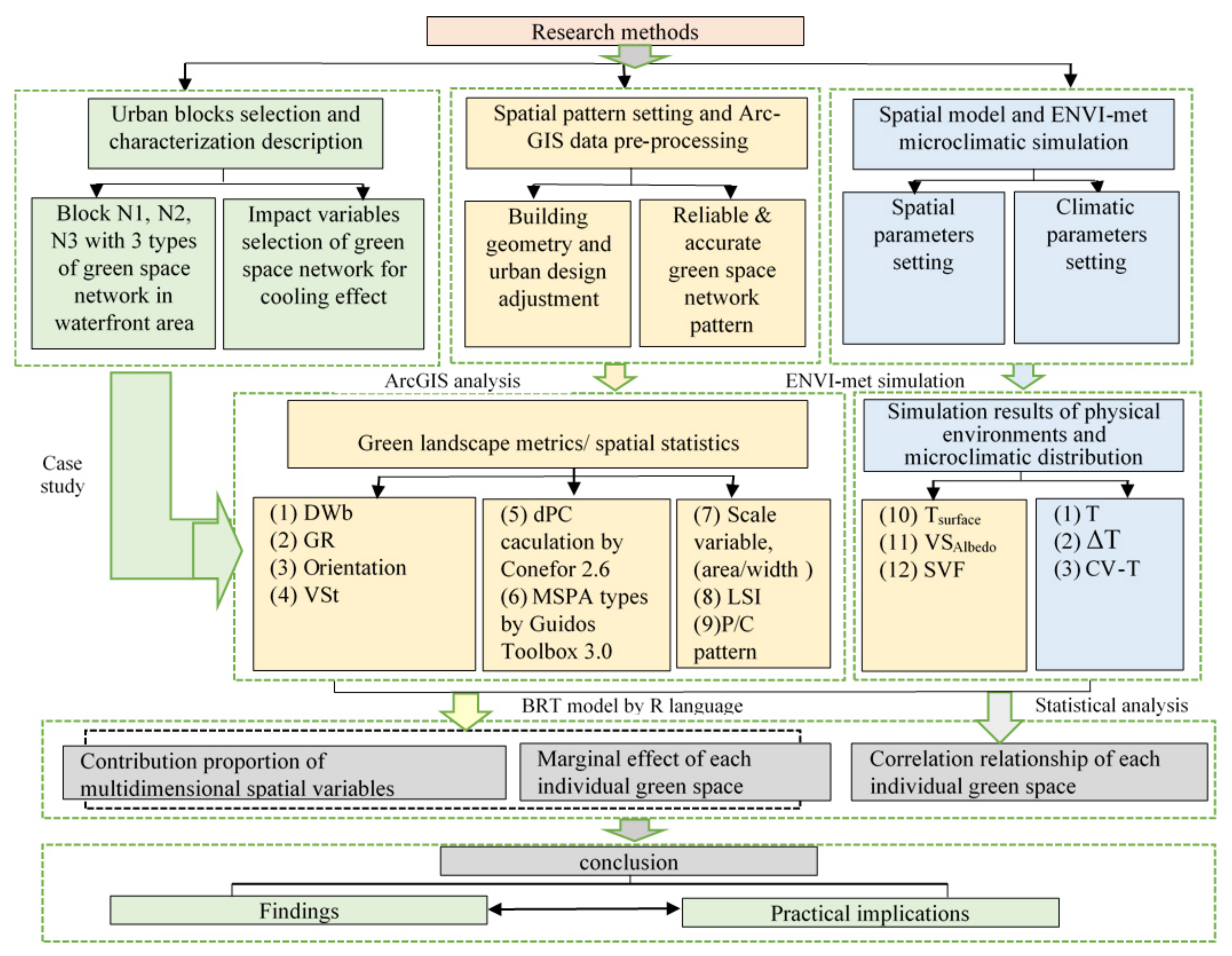
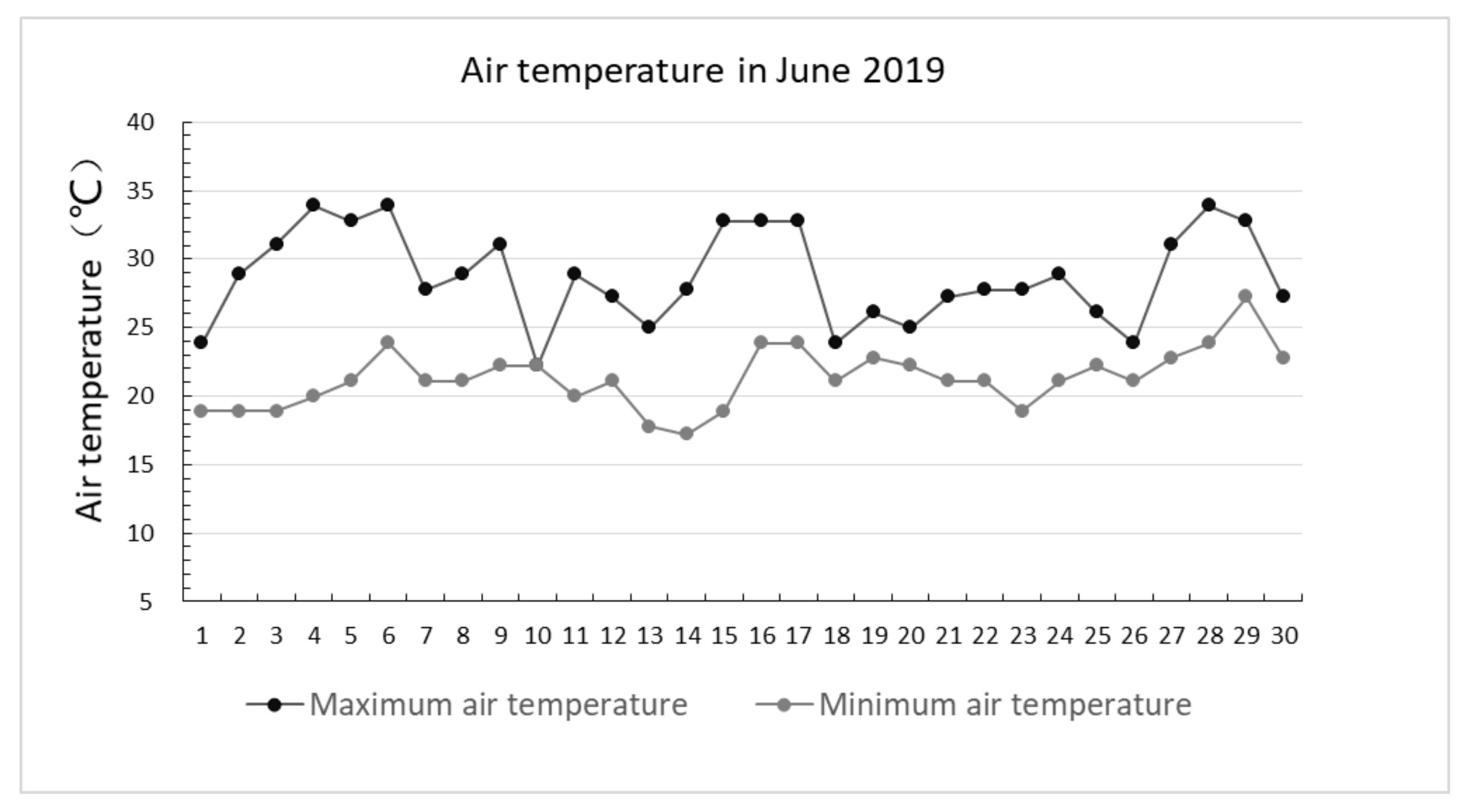
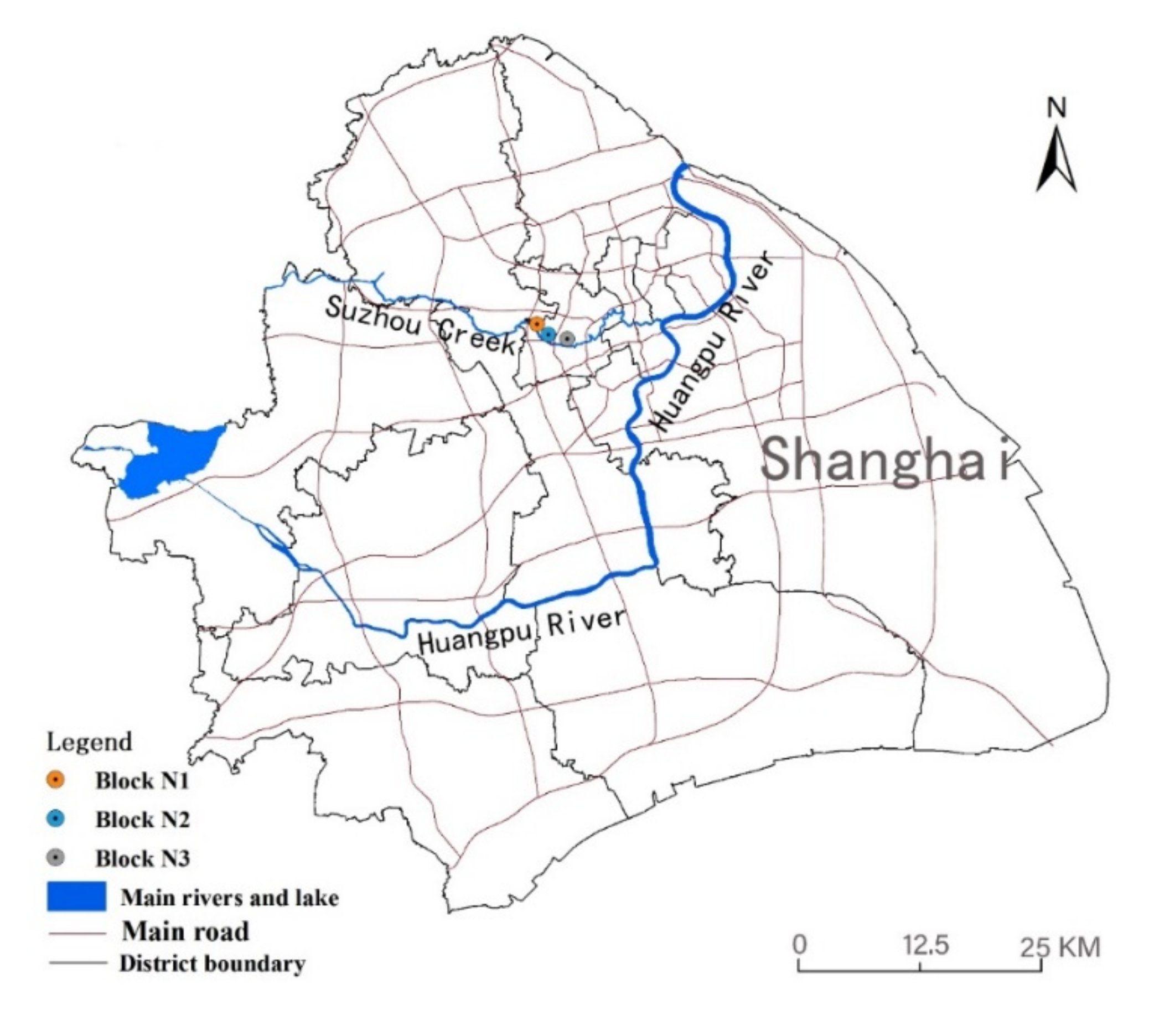
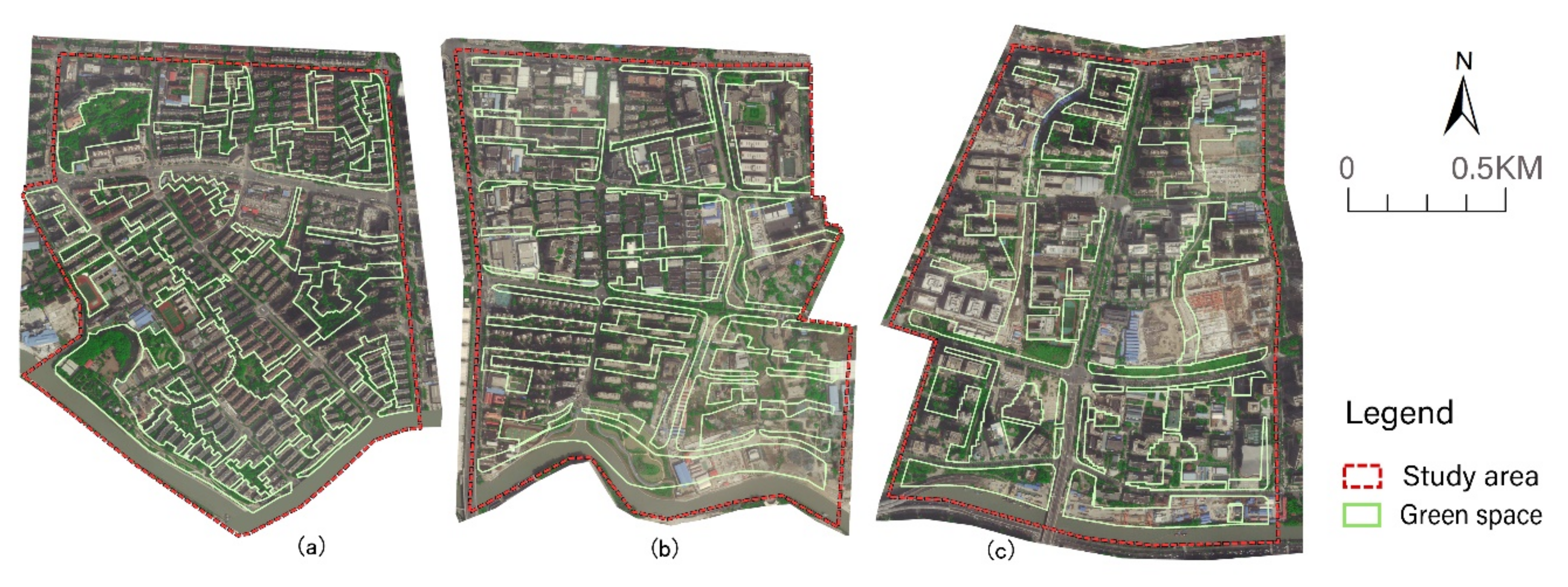
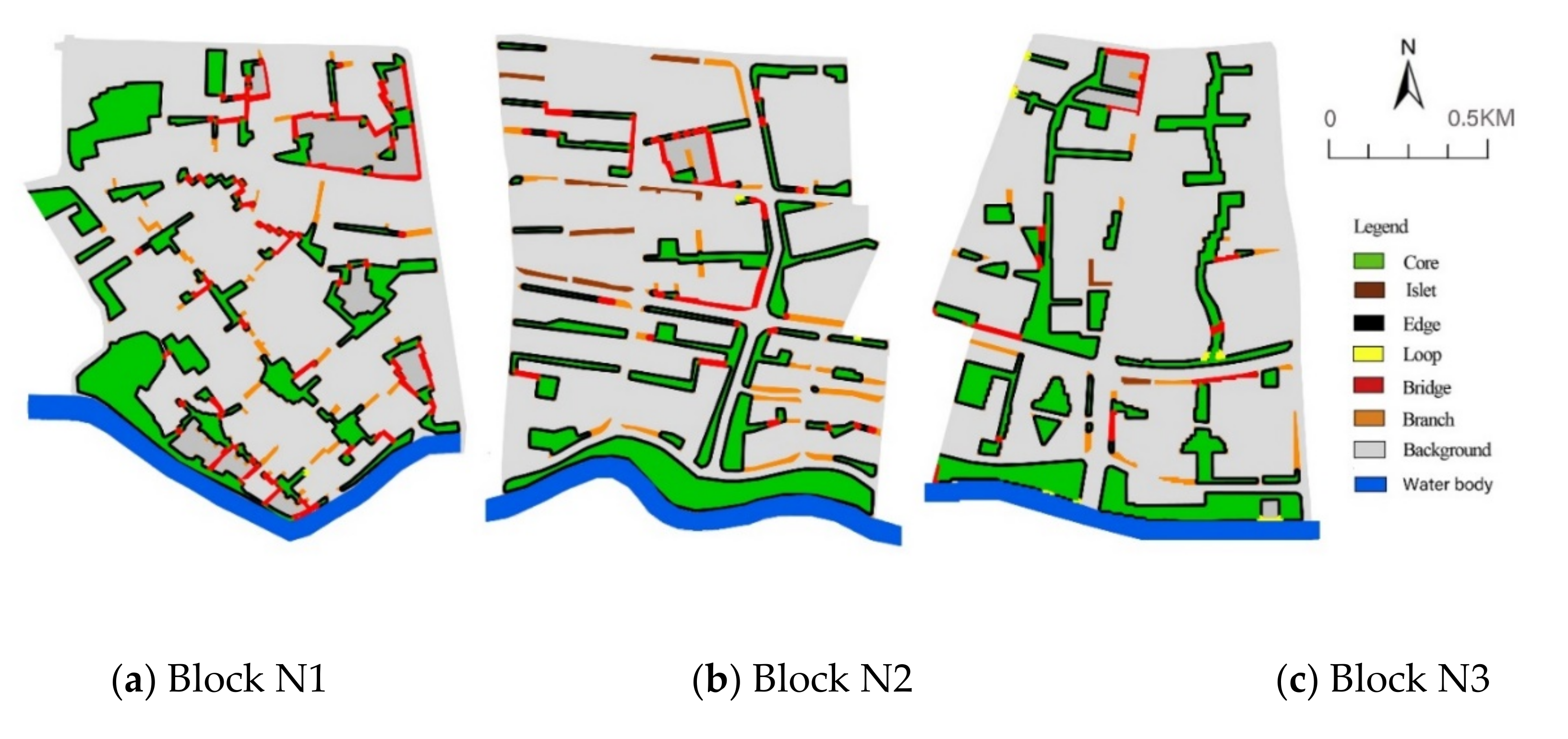
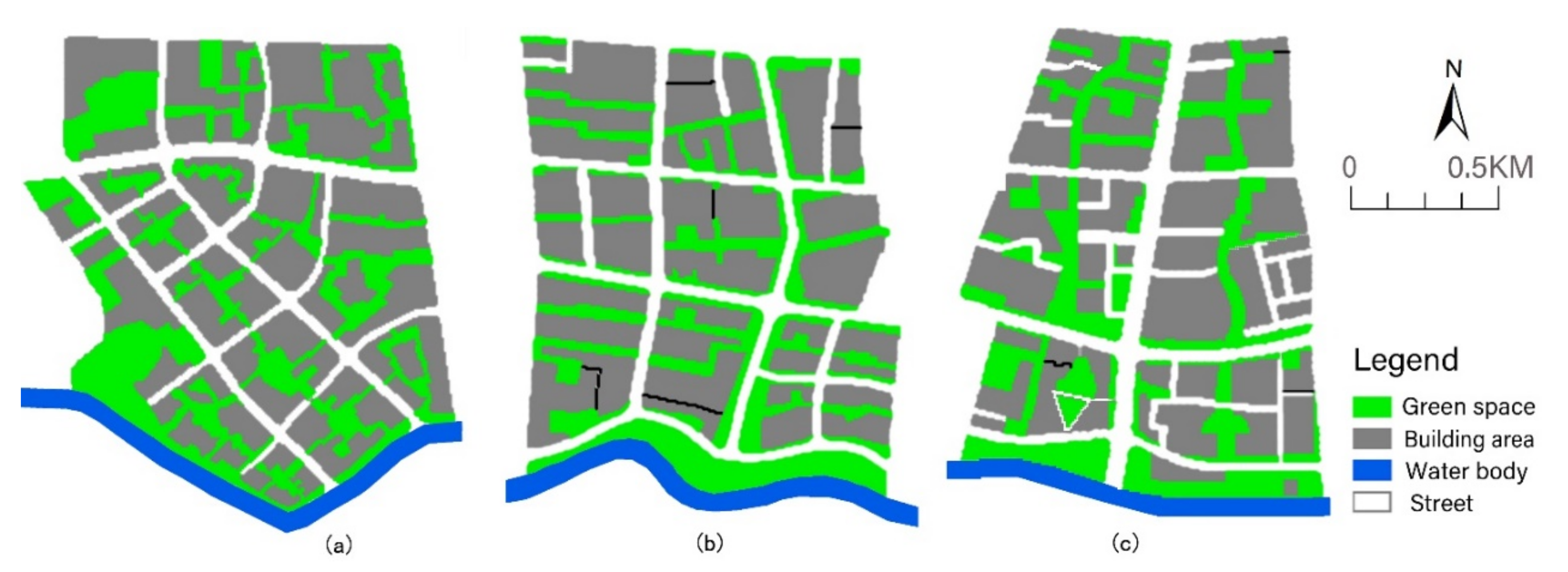

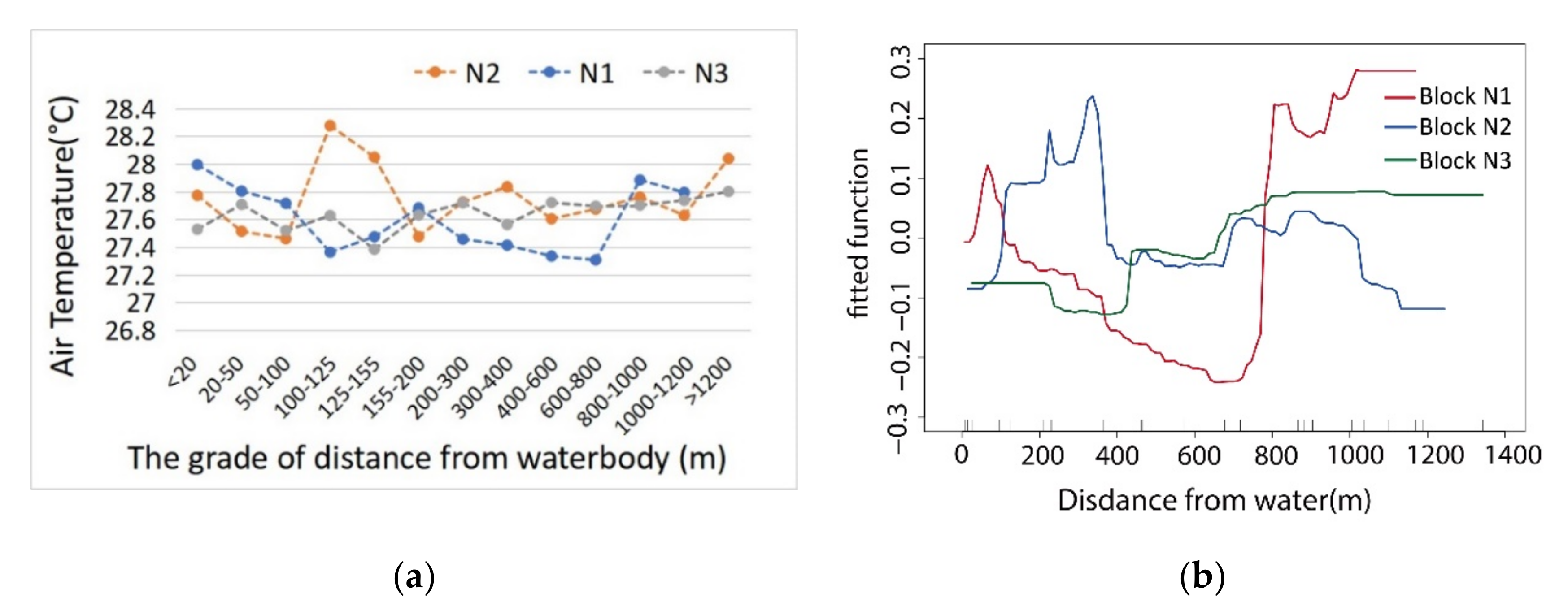
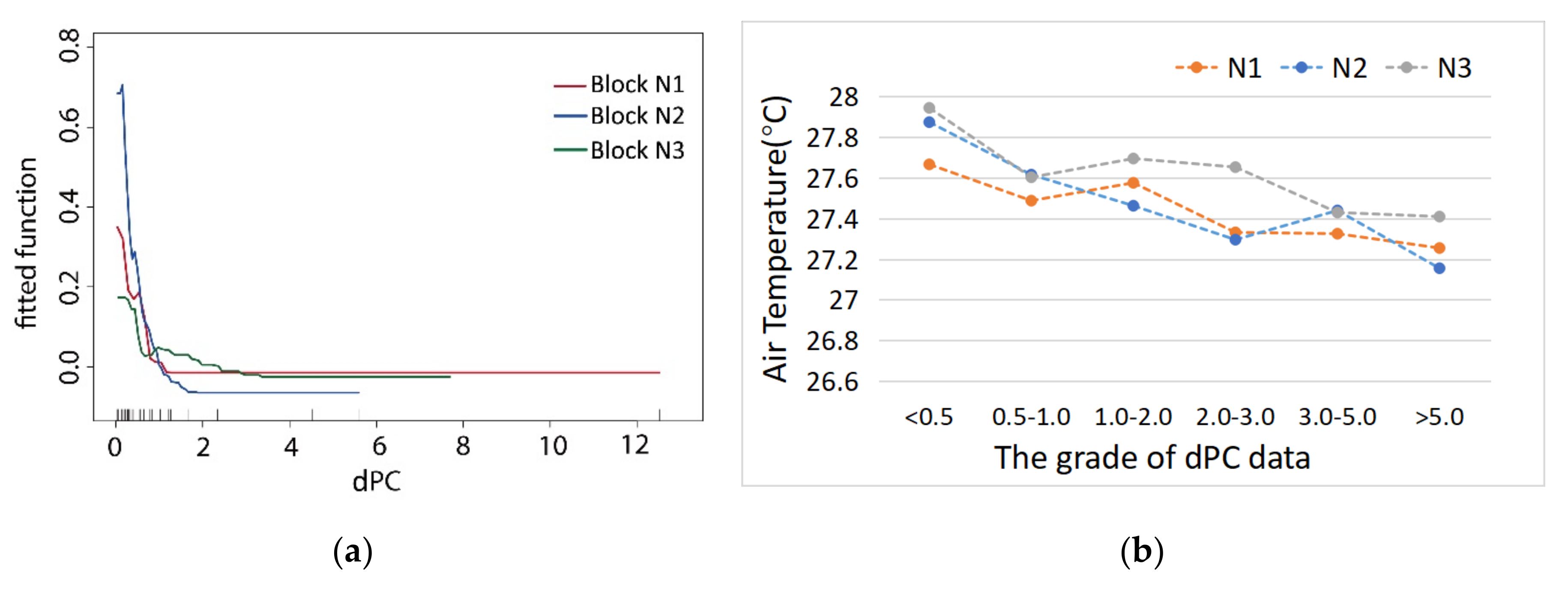
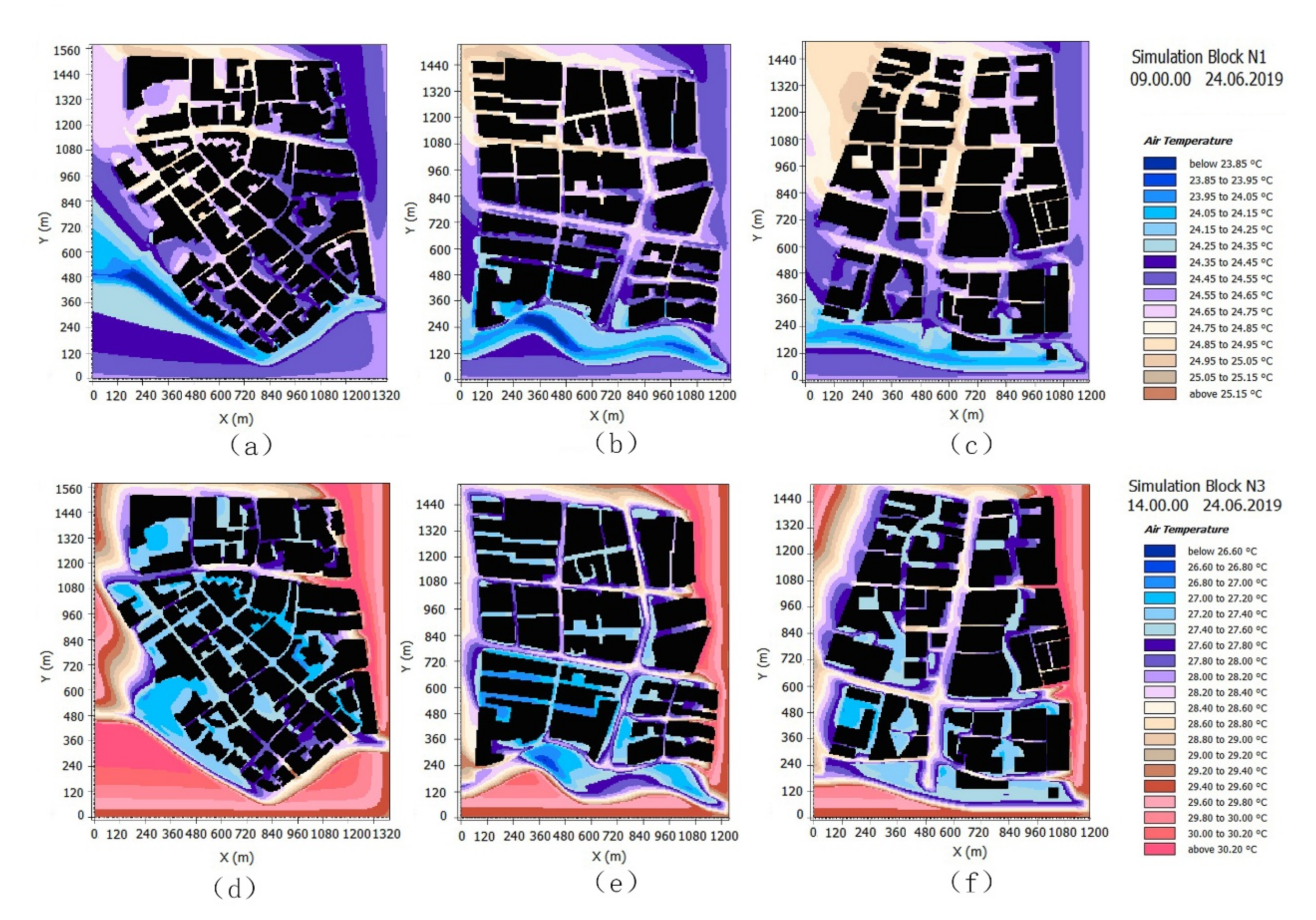

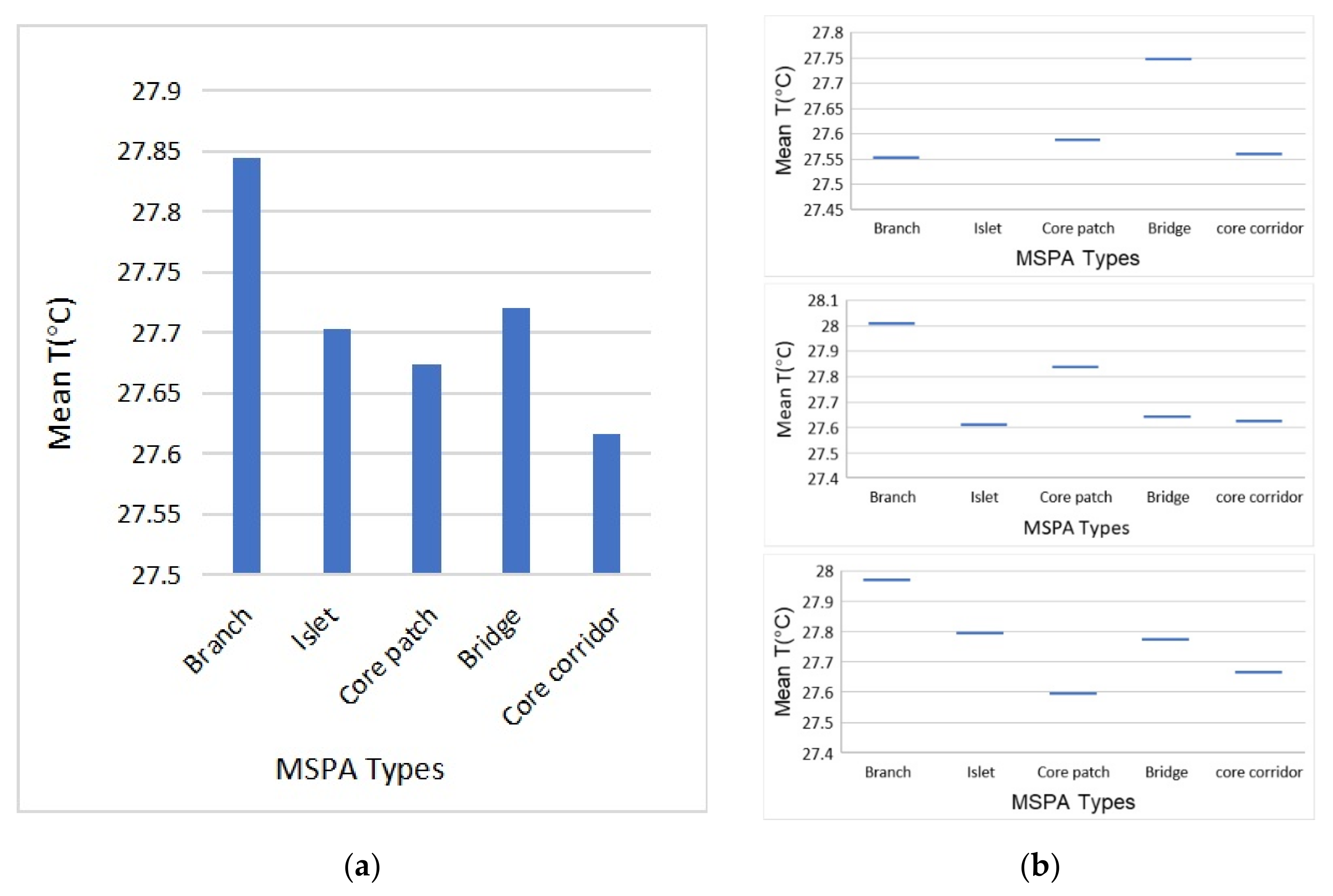
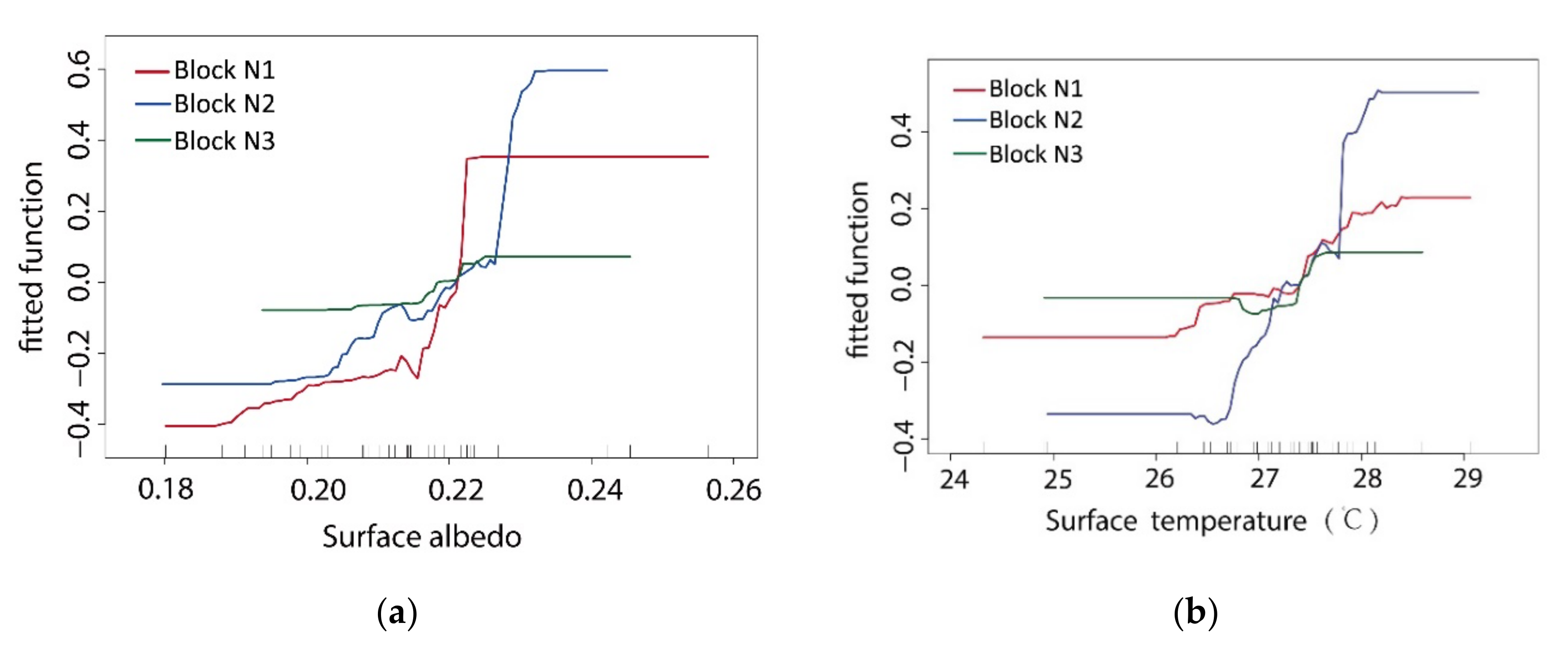
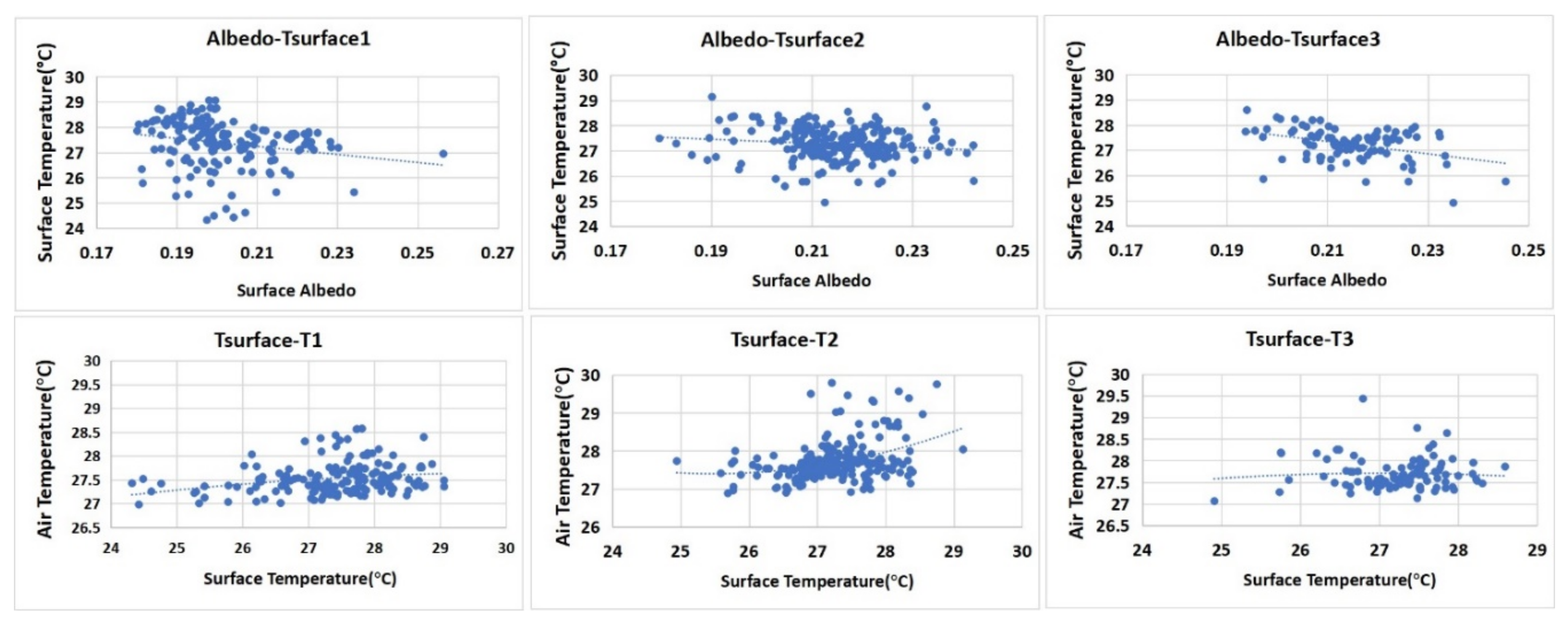


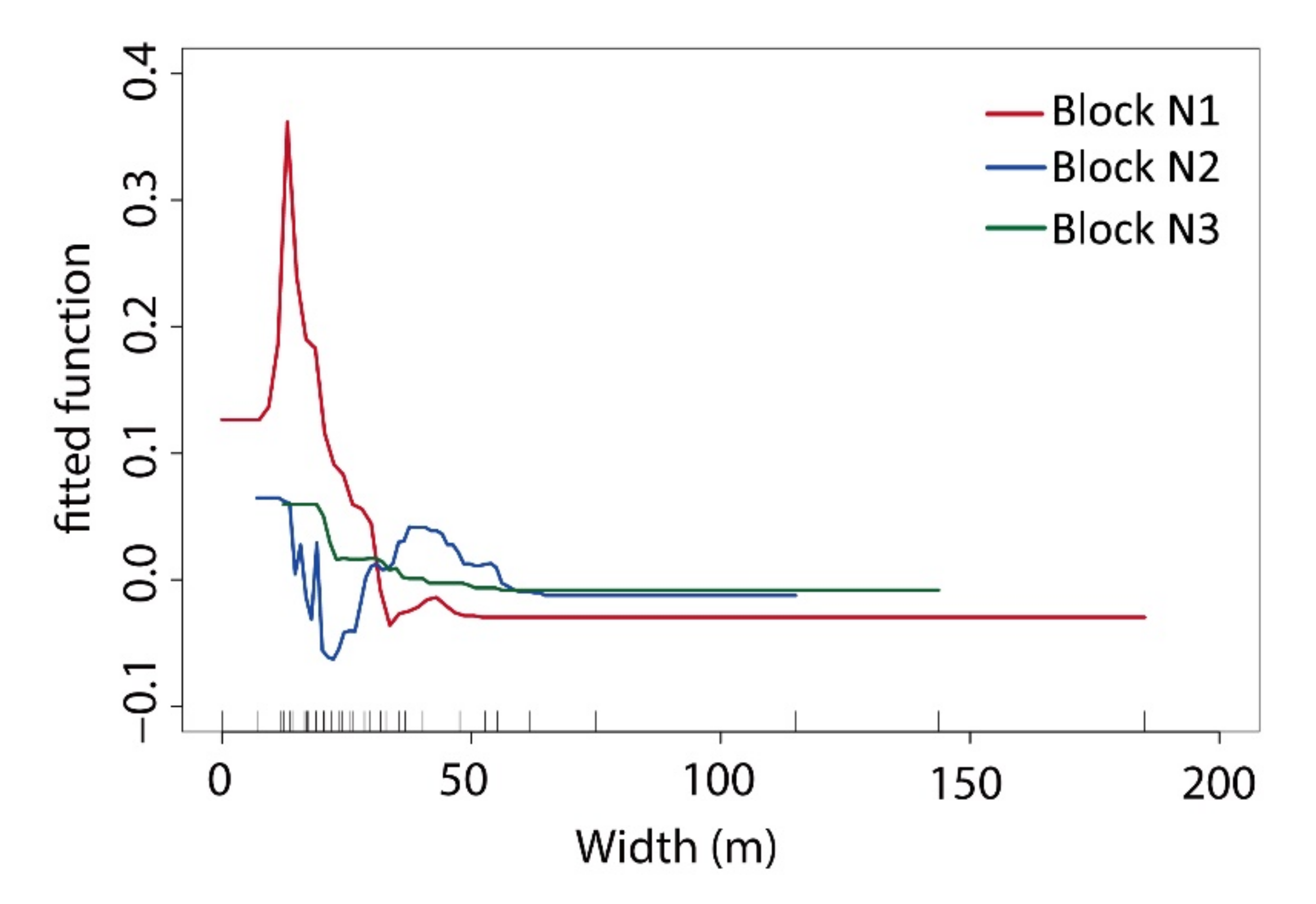

| First Level Variables | Second Level Variables | Definition and Description | Values Assignment | Adapted from |
|---|---|---|---|---|
| Network structure variables | DWb | The distance between the geometric centre of green space and the riverbank representing the influence of the water body on the cooling effect of the green space. | Calculating the distance value via proximity analysis in ArcGIS 10.4 | [1,19] |
| Orientation | The trend of the long side of green space for especially reflecting the cooling influence from the green space corridor and the wind direction inclination angle. | Categorical variable; value 1 = E–W orientation; 2 = S–N; 3 = SW–NE; 4 = SE–NW | [16,34] | |
| MSPA types | The mathematical morphology types by the Morphological spatial pattern analysis (MSPA). The importance of connectivity categories is extracted. | Categorical variable; value 1 = branch; 2 = islet; 3 = core patch; 4 = bridge; 5 = core corridor | [35,36,37] | |
| dPC | The connectivity index characterizing the contribution of each green space in the connectivity to the overall green space network. | Using the data from landscape connectivity evaluation software, Conefor Sensinode 2.6 (by Santiago Saura and Josep Torné, at the Polytechnic University of Madrid and the University of Lleida, Spain) | [38,39,40] | |
| GR | The ratio of the sum of green space area within the scope of land use to the total land use. The values were almost equal in three case study areas. | Presetting to a control variable and excluding from correlation factor analysis | [26,41,42] | |
| VSt | Three-dimensional spatial configuration of vegetation in each green space. The proportions of the vegetation configuration were set the same, the ratio of the number of trees and grass area is 1:30 plant/m2. | Presetting a control variable and excluding it from correlation factor analysis | [27,43] | |
| Spatial morphology variables | GA | The surface area that the green space occupies | Calculating the distance value via spatial analysis in ArcGIS 10.4 | [44,45,46,47] |
| GWd | The cross-sectional width of the green corridor that is perpendicular to the ventilation direction of the green space. | Calculating the distance value by spatial analysis in ArcGIS 10.4 | [48,49] | |
| P/C pattern | Landscape essential factor types of the patch–corridor–matrix model of landscape pattern, for comparison landscape composition of the microclimatic differences. | Categorical variable; value 1 = patch, 2 = corridor | [15,26] | |
| LSI | The shape complexity index measured by calculating the deviation degree between the shape of the green space parcel and its square of the same area. | Calculating by Patch analyst 5.1 package in ArcGIS 10.4 | [15,44] | |
| SVF | The ratio of sky hemisphere visible from the ground (not obstructed by buildings, terrain or trees), three-dimensional morphological parameters. | Simulation data of the surface conditions via ENVI-met 4.4. | [28,42,50] | |
| VSAlbedo | The ratio of the surface reflection flux to the incident solar radiation flux on the surface of green space. | Simulation data of the VSAlbedo via ENVI-met 4.4 | [6,29] | |
| Tsurface | The ground surface temperature of green space, representing the impact from the three-dimensional spatial difference of green space and ambient factors. | Simulation data of the T surface via ENVI-met 4.4. | [6,29] |
| Input Parameters | T (℃) | Wind Orientation | WS (M/S) | Humidity (%) | Roughness |
|---|---|---|---|---|---|
| Value | 24.51 | 135 ° | 5.53 | 66.46 | 0.01 |
| Simulation Parameter Settings | Area | ||
|---|---|---|---|
| Block N1 | Block N2 | Block N3 | |
| Number of grids (x, y, z) | 233, 263, 45 | 206, 256, 45 | 198, 253, 45 |
| Size of grid cell (m) (dx, dy, and dz) | 6, 6, 3 | 6, 6, 3 | 6, 6, 3 |
| The material for nesting grids | Soil A: Loamy Soil Soil B: Loamy Soil | Soil A: Loamy Soil Soil B: Loamy Soil | Soil A: Loamy Soil Soil B: Loamy Soil |
| Default wall material | moderate insulation | moderate insulation | moderate insulation |
| Default roof material | moderate insulation | moderate insulation | moderate insulation |
| Street material | Loamy Soil | Loamy Soil | Loamy Soil |
| Spatial Variables of Morphological Indices | Relative Importance of Predictor Variables | ||
|---|---|---|---|
| Block 1 | Block 2 | Block 3 | |
| DWb | 18.11% | 10.79% | 14.78% |
| VSAlbedo | 21.89% | 16.72% | 10.00% |
| Tsurface | 6.61% | 18.45% | 9.77% |
| dPC | 4.09% | 19.34% | 14.52% |
| MSPA types | 1.46% | 5.24% | 5.11% |
| SVF | 22.18% | 10.53% | 22.69% |
| MSI | 5.29% | 6.60% | 8.56% |
| GWd | 10.67% | 3.69% | 5.48% |
| VSt | 2.78% | 1.29% | 3.28% |
| GA | 3.50% | 7.06% | 5.47% |
| Orientation | 3.23% | 0.24% | 0.33% |
| P/C pattern | 0.18% | 0.06% | 0.00% |
Publisher’s Note: MDPI stays neutral with regard to jurisdictional claims in published maps and institutional affiliations. |
© 2020 by the authors. Licensee MDPI, Basel, Switzerland. This article is an open access article distributed under the terms and conditions of the Creative Commons Attribution (CC BY) license (http://creativecommons.org/licenses/by/4.0/).
Share and Cite
Jiang, Y.; Jiang, S.; Shi, T. Comparative Study on the Cooling Effects of Green Space Patterns in Waterfront Build-Up Blocks: An Experience from Shanghai. Int. J. Environ. Res. Public Health 2020, 17, 8684. https://doi.org/10.3390/ijerph17228684
Jiang Y, Jiang S, Shi T. Comparative Study on the Cooling Effects of Green Space Patterns in Waterfront Build-Up Blocks: An Experience from Shanghai. International Journal of Environmental Research and Public Health. 2020; 17(22):8684. https://doi.org/10.3390/ijerph17228684
Chicago/Turabian StyleJiang, Yunfang, Shidan Jiang, and Tiemao Shi. 2020. "Comparative Study on the Cooling Effects of Green Space Patterns in Waterfront Build-Up Blocks: An Experience from Shanghai" International Journal of Environmental Research and Public Health 17, no. 22: 8684. https://doi.org/10.3390/ijerph17228684
APA StyleJiang, Y., Jiang, S., & Shi, T. (2020). Comparative Study on the Cooling Effects of Green Space Patterns in Waterfront Build-Up Blocks: An Experience from Shanghai. International Journal of Environmental Research and Public Health, 17(22), 8684. https://doi.org/10.3390/ijerph17228684





